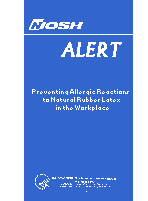Preventing Allergic Reactions to Natural Rubber Latex in the Workplace
Because of issues raised in the Alert, FDA subsequently banned use of powdered medical gloves in the USA: https://www.federalregister.gov/documents/2016/12/19/2016-30382/banned-devices-powdered-surgeons-gloves-powdered-patient-examination-gloves-and-absorbable-powder.
Any U.S. Food and Drug Administration (FDA)-cleared medical glove, regardless of material it is made from, can be used as appropriate for its medical use (surgical, exam, procedure). Users should avoid wearing particular glove products if they are allergic to composition materials or additives present in the gloves and not use them to care for patients with such allergies. To identify FDA-cleared medical gloves, search the 510(k) Premarket Notification database using the FDA’s product codes for glove types.
June 1997
DHHS (NIOSH) Publication Number 97-135

Latex products are manufactured from a milky fluid derived from the rubber tree, Hevea brasiliensis. Several chemicals are added to this fluid during the processing and manufacture of commercial latex. Some proteins in latex can cause a range of mild to severe allergic reactions. Currently available methods of measurement do not provide easy or consistent identification of allergy-causing proteins (antigens) and their concentrations. Until well accepted standardized tests are available, total protein serves as a useful indicator of the exposure of concern [Beezhold et al., 1996a]. The chemicals added during processing may also cause skin rashes. Several types of synthetic rubber are also referred to as “latex,” but these do not release the proteins that cause allergic reactions.
Preventing Allergic Reactions to Natural Rubber Latex in the Workplace [PDF – 9 MB]
